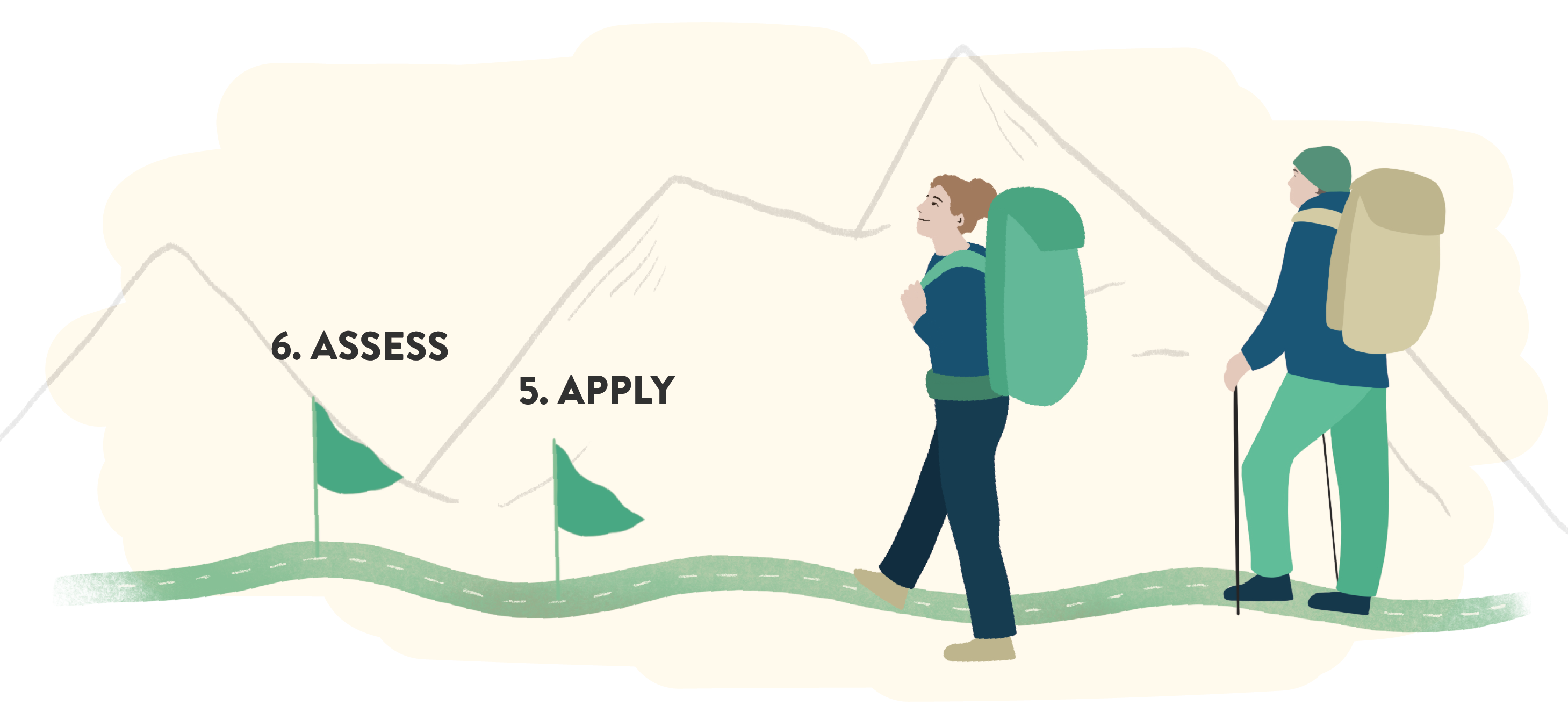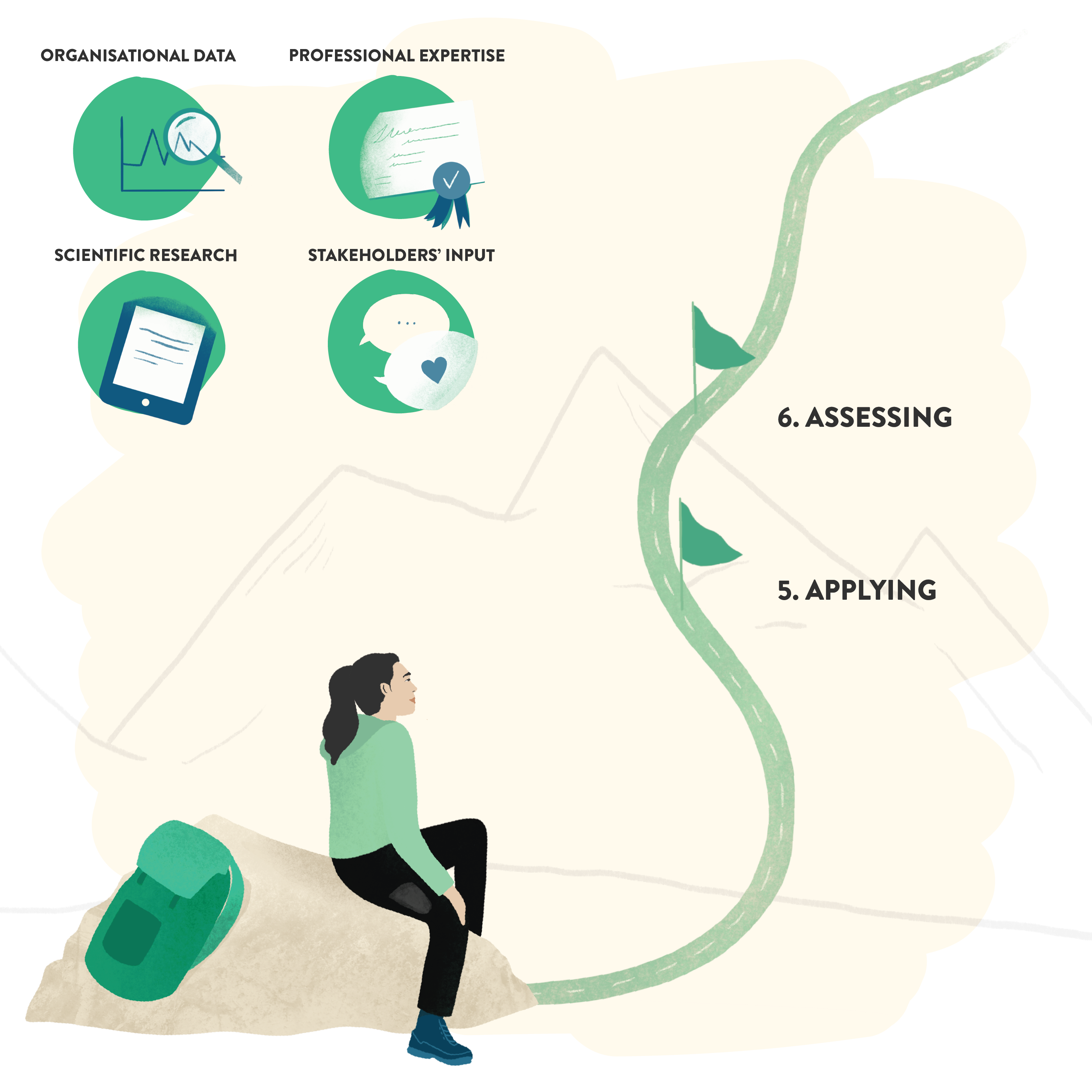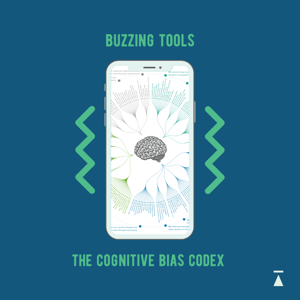#Evidence Based HR #Blogpost
HR evidence is only useful if it leads to action. And assessing how decisions work out creates new evidence. Discover how it works.
Episode 6: The Evidence-Based HR Backpack – Apply & Assess
Learn how to apply evidence and assess results in evidence-based HR
Most job adverts today will request evidence of work experience in the area in question. But surprisingly, scientific research indicates that experience in previous jobs and organisations is generally a poor predictor of job performance. Instead, a person’s general mental capability, also known as cognitive ability, is the best predictor of performance across jobs. However, candidates aren’t great fans of cognitive ability assessments, especially if it means they lose a job to a less experienced competitor.
We’re talking about evidence Evi, the HR manager of bicycle manufacturer BisonBikes, has collected and evaluated while looking for a more effective way of screening candidates. How can she apply these pieces of contradictory evidence to her decision? And how can she assess whether the decision has been right for the organisation? Questions… questions.
Evidence-based decisions can contain uncertainty
Using evidence in decisions doesn’t necessarily mean having absolute proof: evidence helps you to understand the likelihood for certain solutions to work before implementing them. So, if you want to select better-performing candidates (outcome), one possible solution is screening all applicants for cognitive ability.
Using evidence in decisions doesn’t necessarily mean having absolute proof.
What are the chances of this working? Put another way, what’s the probability that someone’s cognitive ability will give Evi a clue to their future performance in BisonBikes?
What to do with the evidence, once you have it
In our other articles, we discuss how to collect and recognise evidence from the four sources (scientific research, organisational data, professional expertise and stakeholders’ input) to make evidence-based HR decisions. These were the first steps of the 6As process.
Here’s what comes next: how to apply evidence and how to assess the outcomes of the decision. Logical, really.

-

Apply: turning evidence into action
First, think of costs and benefits (“If I apply it and it works, what would I gain?”). Balance both sides of the coin on a case-by-case basis. Sometimes, the potential gains of a decision are so great that you can take the risk even if it might not work. On the other hand, if candidates react negatively to the cognitive ability assessment, Evi might lose all of them before hiring. So, take each case as it comes, and apply the evidence you’ve uncovered.
Once you’re ready to implement what you’ve discovered, provide user-friendly and accessible tools to people who need to work with it. Evi gives recruiters flowcharts of the new selection process, finds a decent tool to assess cognitive ability and trains the recruiters on how to use it.
-

Assess: experimenting to obtain new evidence
The exciting bit. Every decision is an experiment and a learning opportunity – feedback about how a decision has played out is a requirement for building professional expertise.
When evaluating an evidence-based decision, first look at how it was executed. Did Evi’s team of recruiters actually use the new cognitive ability and consciousness assessment tool to select candidates? You can only accurately measure their effects if the solutions are implemented correctly.
Ideally, Evi will assess the outcomes of a decision through an experiment comprised of three elements:
-
- Control group: a group of recruiters doing things the old way, in parallel with the group implementing the new flowchart and cognitive ability tool.
- Random assignment: recruiters get assigned so that the two groups are likely to be similar and have the same level of recruiting competencies.
- Before-and-after measurement: Evi measures the job performance of candidates hired by all recruiters before making any change. Then, she starts the experiment and after three months, she remeasures the performance of the candidates the recruiters selected during this time. Evi will be able to compare the performance of candidates selected in the old way with that of candidates selected using the new flowchart and cognitive ability tool.
-
In reality, within organisations, it’s not always possible to run true experiments – because, after all, they’re not scientific labs. Applying only two or even one of the three points above still provides valuable data. And if you’re unable to collect any data at all, then organise a debriefing session. This gives people the opportunity to reflect on their experience and is still useful for learning.
HR evidence is only useful if it leads to action and to continuous learning.
The right mindset is key
Applying and Assessing are the final two pieces in the evidence-based HR process puzzle. However, beyond a procedure with steps and tools, evidence-based decision-making is a way of thinking about decisions and balancing information. Scientific research is an objective and trustworthy source of evidence, but ignoring candidates’ reactions can be misguided – like using a cognitive ability assessment without any hesitation.

As we covered off in previous articles, evidence-based HR is about both objective information and subjective input, especially derived from stakeholders. Follow our page to read about other topics in HR and train your evidence-based mindset. The proof is in the successful end result.
If you got excited about Evidence-Based practice and want to find out all the details about it, we recommend the book written by our partners at CEBMa:
The book is a step-by-step guide with all the information you need to become an evidence-based practitioner.
For more inspiration and freely available resources, check the websites of our partners CEBMa and ScienceForWork.
Would you like to interact about EBHR and learn together with other people? Then you’re welcome to join our knowledge sharing forum for EBHR-learners on Facebook, and our open workshops. We're also happy to provide a custom session for your organisation, online or offline.
All blog posts of this series on The Evidence-Based HR Backpack will be bundled for you in an illustrated ebook, with additional comments from some of our partners. From next week this will be freely available to you on our website.
Stay tuned for the continuation of the story. In the next series we will immerse ourselves in the wonderful world of evidence-based recruitment.
Iulia Cioca & Edward Vanhoutte
Iulia, a graduate in Work and Organizational Psychology from the University of Valencia, with a diverse educational background spanning Romania, Austria, Italy, and Canada, specializes in HR advisory. She is HR Scientist at Balance HR, dedicated to evidence-based HR practices, and a CEBMa fellow and PhD candidate. Edward, the managing partner of Balance HR and a fellow of CEBMa, specializes in building high-impact HR teams and promoting evidence-based HR practices. In addition, he has a keen interest in graphics and societal initiatives.



